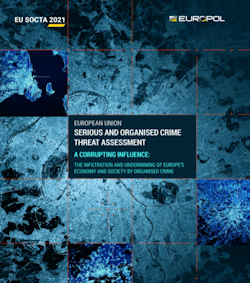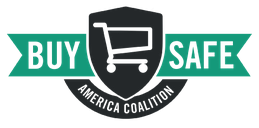European Union (EU) 'Serious and Organized Crime Threat Assessment,'
the EU SOCTA 2021
"Virtually all criminal
activities now feature an online component & many crimes have fully migrated
online."
Published Every
4 Years - Equivalent to the U.S. FBI's Annual Crime Index
Organized Crime "THE MOST PRESSING INTERNAL SECURITY THREAT TO THE EU"
COVID's Impact - Online & Offline Fraud - Violence
Increasing - All Crime has Online Component
Europol publishes its Serious and Organised Crime Threat Assessment 2021
 Europol
publishes the European Union (EU) Serious and Organised Crime Threat Assessment,
the
EU SOCTA 2021. The SOCTA, published by Europol every four years,
presents a detailed analysis of the threat of serious and organised crime facing
the EU. The SOCTA is a forward-looking assessment that identifies shifts in
the serious and organized crime landscape.
Europol
publishes the European Union (EU) Serious and Organised Crime Threat Assessment,
the
EU SOCTA 2021. The SOCTA, published by Europol every four years,
presents a detailed analysis of the threat of serious and organised crime facing
the EU. The SOCTA is a forward-looking assessment that identifies shifts in
the serious and organized crime landscape.
The SOCTA 2021 details the operations of criminal networks in the EU and how
their criminal activities and business practices threaten to undermine our
societies, economy and institutions, and slowly erode the rule of law. The
report provides unprecedented insights into Europe’s criminal underworld based
on the analysis of thousands of cases and pieces of intelligence provided to
Europol.
The SOCTA reveals a concerning expansion and evolution of serious and
organised crime in the EU. The document warns of the potential long-term
implications of the COVID-19 pandemic and how these may create ideal
conditions for crime to thrive in the future.
As the EU is facing the COVID-19 pandemic, one of the most significant crises
since the end of World War II, criminals seek to exploit this extraordinary
situation targeting citizens, businesses, and public institutions alike.
Key findings of the SOCTA 2021:
● Serious and
organized crime has never posed as high a threat to
the EU and its citizens as it does today.
● The COVID-19 pandemic and the potential economic
and social fallout expected to follow threaten to create
ideal conditions for organized crime to spread and take hold in the EU
and beyond
● The trafficking and exploitation of human beings, migrant smuggling,
online and offline frauds and property crime pose
significant threats to EU citizens.
● Around 60 % of the criminal networks active in the EU
use violence as part of their criminal businesses.
● More than 80 % of the criminal networks use legal
business structures
● The use of violence by criminals involved in
serious and organised crime in the EU appears to have
increased in terms of the frequency of use and its severity. The threat
from violent incidents has been augmented by the frequent use of firearms or
explosives in public spaces.
● Criminals are digital natives. Virtually all criminal
activities now feature some online component and many crimes have fully migrated
online. Criminals exploit encrypted communications to network among each
other, use social media and instant messaging services
to reach a larger audience to advertise illegal goods,
or spread disinformation.
Organized Property Crime: Fencing and Organized burglaries and thefts
Fencing is knowingly buying and selling stolen goods. Organized property
crime fundamentally relies on fences. However, the processes and networks
behind fencing are largely under-investigated. Key locations and routes for
stolen goods are currently intelligence gaps.
Organized property crime is likely the most visible type of organized
crime, with a direct impact on people and the private and public sector. More
than one million cases related to burglary are reported in the EU each
year(52).
Stolen goods are sold in shops usually in the home country of the criminals
or in the country of the theft or other countries depending on the availability
of local fencing networks. Another important sales channel are online platforms.
europol.europa.eu
SOCTA 2021 - report
Editor's Note: The report is virtually a mirror of the U.S. As they're
facing the same challenges we are. With COVID's impact, online and offline fraud
increasing, violence increasing, and the fact that virtually all crimes feature
some, if not all, online components.
 Interestingly,
only four pages are dedicated to organized property crime and organized
retail crime isn't even mentioned as a phrase. With only one reference to
'shoplifting.' The issue may be that they go into great detail discussing
organized robberies in retail businesses and this may represent their category
for ORC.
Interestingly,
only four pages are dedicated to organized property crime and organized
retail crime isn't even mentioned as a phrase. With only one reference to
'shoplifting.' The issue may be that they go into great detail discussing
organized robberies in retail businesses and this may represent their category
for ORC.
On a side note, this doesn't help our
Buy Safe effort in
Congress. As Congress has nothing to look at as examples to measure against and
law enforcement isn't even calling it the same thing.
Another alarming finding is that 80% of organized crime is managed like
successful business models with managerial levels, field operators, that are
surrounded by a range of actors linked to the crime infrastructure providing
support services.
This all being said means, that as the crimes persist and continue to grow
globally the 'Buy Safe' movement in the U.S. ultimately needs to become a global
effort. Actually, it may become an inevitable development by itself, in response
to the increasing activity, level of sophistication and organizational
structure, and the sheer dollar size of the frauds increasing.
In response the nexus between loss prevention and cybersecurity, it will
continue to evolve and grow even closer. To the point of potentially being one
unit in the future.
As stated above this is Europe's equivalent to the U.S.'s FBI Annual Crime Index
with one major difference: the analysis, insightfulness and explanation of
activity. As they try to develop a picture of what organized crime looks like in
the EU for the reader. However, it does lack the numbers and data the FBI's
Crime Index provides. Just some thoughts. - Gus Downing